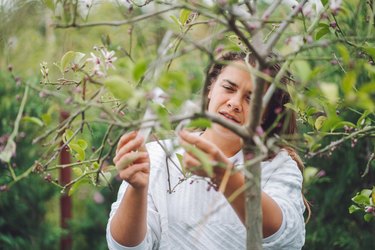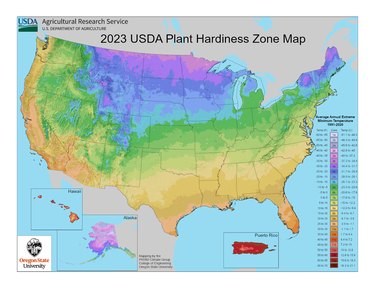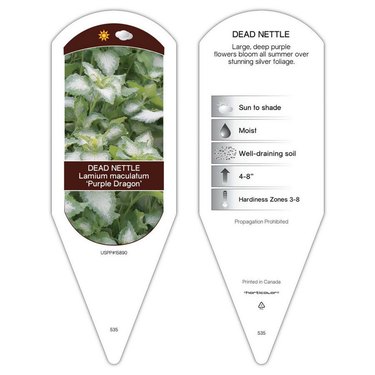When you take the trouble to put shrubs in the backyard, you want them to last through the winter. Gardeners around the country count on the USDA Plant Hardiness Zone Map to help them pick plants that will thrive in their climate. The map divides the country into "zones" based on average lowest winter temperatures.
This map was updated in the end of 2023 for the first time since 2012. If you're familiar with the old map, you'll notice right away that the new map is more accurate and detailed. It's very easy for anyone to use, so don't hesitate to visit the Department of Agriculture webpage to get the latest info on your hardiness zone.
Video of the Day
Video of the Day
What Are Plant Hardiness Zones?
When you are thinking of putting new plants in your landscape, there are many important considerations to keep in mind, including sun exposure, soil and wind protection, but none is more important than your region's climate. Picking plants hardy to your region is essential.
That's where the USDA Plant Hardiness Zone Map comes in handy. Understanding and using this map allows a gardener to select flowers, shrubs and trees that can survive winters in their specific region.
Gardeners and growers rely on the USDA Plant Hardiness Zone Map to determine which perennial plants are most likely to grow and thrive at their location. The map is based on the average lowest winter temperature of each region of the United States and its territories. Dipping winter temperature is perhaps the single most significant factor in plant survival for any area.
The map divides the country into 13 hardiness zones, with each zone further divided into "a" and "b" sub-zones. (Zone 1a is the coldest, zone 13b the warmest.) For example, Houston, Texas, is in zone 9a, so a gardener there would need to select plants that are hardy to that zone.

Many plants sold in nurseries have tags specifying their hardiness zone range, also known as their planting or growing zones. It is also possible to find growing zone information about a plant with a simple online search. For example, if you search "growing a weeping willow," you will find that the planting zone for a weeping willow (Salix babylonica) is zones 6 through 9. That means that it would work for a garden in Houston.
The New USDA Zone Map
The United States Department of Agriculture first published a map of hardiness zones in 1960, but it was based on regional temperature information from only several hundred weather stations. The map truly became a more valuable reference in 1990, when the USDA worked hand in hand with the U.S. National Arboretum to revamp the old map using climate data from thousands of weather stations.
Each update of the hardiness map has improved its accuracy and expanded the detail of the temperature ranges. The newest version of the USDA map was published in November 2023.
More Accurate Information
The USDA hardiness map is divided into 10-degree Fahrenheit zones, each one divided further into 5-degree Fahrenheit half zones. The 2023 version of the hardiness map is more accurate than past versions since the zoning is based on information from 13,412 weather stations. The information allows them to determine accurate 30-year averages of the lowest annual winter temperatures at different locations around the country.
The new map also includes more detailed information from states and territories that are not part of the continental United States. For example, the resolution for Alaska is significantly improved in the 2023 USDA map.
Zone and Subzone Updates
Even if you are familiar with the older USDA map, be sure to check out your zone in this new version. With the updated weather data, almost half of the nation shifted to a warmer zone, usually to the next half zone. That means that some cities that were in USDA hardiness zone 4a may have moved to 4b, and those in 4b to 5a. Other regions had no change.
If the widespread bump-up in zones makes you think of climate change, you're not alone. But this is not necessarily the cause of the changes. The Department of Agriculture attributes some of the "warming" to their incorporation of more recent temperature data. For example, the new map for Alaska contains more data representing the state's mountain regions where, during winter, the weather is warmer than in the low-elevation valleys. Some zone boundaries have also been fine-tuned by more sophisticated mapping methods.
How to Find Your Hardiness Zone
You can easily determine your current hardiness zone using nothing more than your zip code, thanks to the tools offered online by the Department of Agriculture. Just plug in your zip code on the USDA Plant Hardiness Zone Map website and you'll find that region of the new map appear, color coordinated with the hardiness zone. If there are several hardiness zones in that zip code, zoom in on the interactive map to find your exact location.
Alternatively, you can look at the plant hardiness zone map of the country. It is color coded, and you can find your region and determine your hardiness zone. You can also click on your state name and get a more detailed map focusing on your state.
What Does a Hardiness Zone Mean to You?
Once you know your hardiness zone, you have an invaluable tool available for selecting your perennial plants. Perennials are those flowers or bushes with a life span of more than two growing seasons. Contrast these to annuals: plants that sprout, bloom, seed and die in one growing season (or biennials, which have a two-year life cycle). Annuals—including vegetables and annual flowers like California poppies (Eschscholzia californica)—are not affected by winter weather, because they live for only one growing season. That's why hardiness and planting zones are more useful for home gardeners selecting perennials.
Perennials emerge from one year to the next only if they are hardy enough to survive the winter in their planting region. So it's important to select perennial flowers, bushes and trees with stated growing zones that include your hardiness zone.
When possible, pick plants that are not just marginally hardy to your zone. For example, if you live in USDA hardiness zone 6a, a bush with a plant hardiness range 6 to 8 might work out just fine, but an unusually cold winter could damage or kill it. For a safer bet, pick a bush with a planting zone range down to zone 5, which is far less likely to suffer winter damage or its effects, such as poor growth and loss of blossoms.

